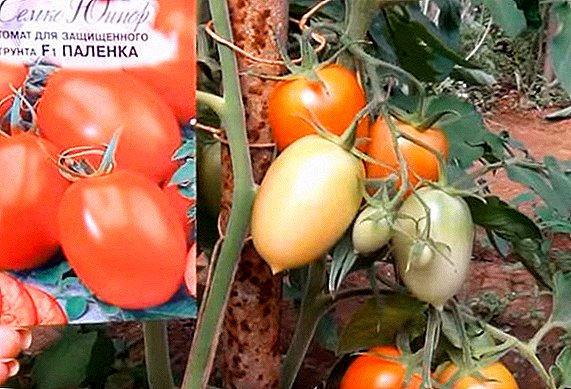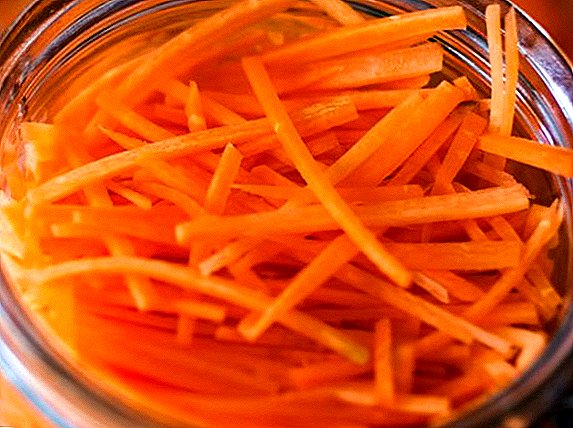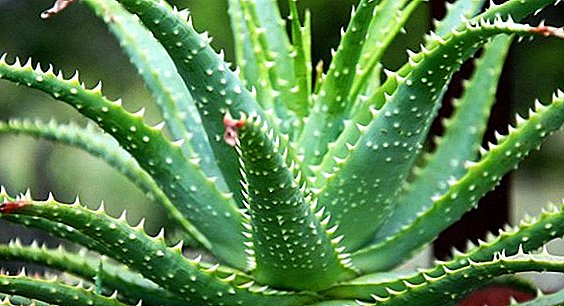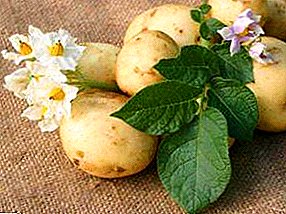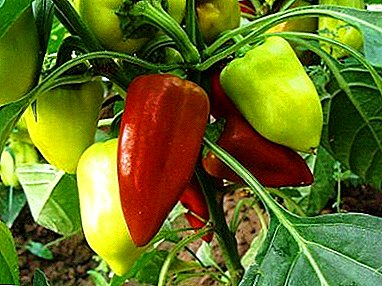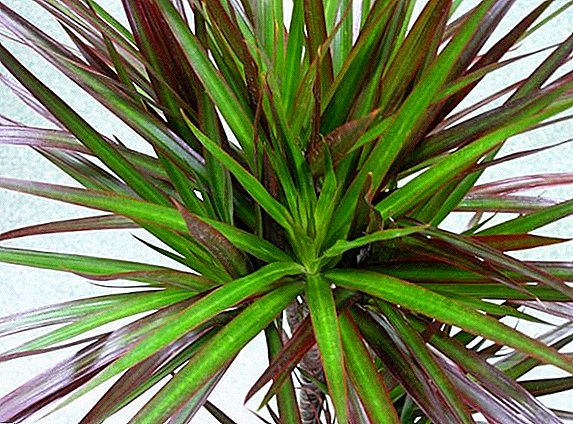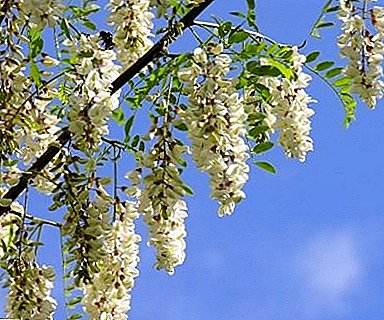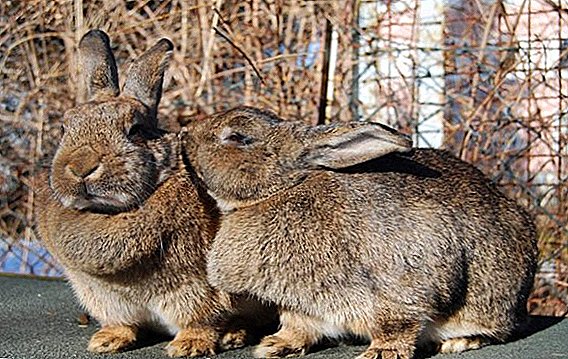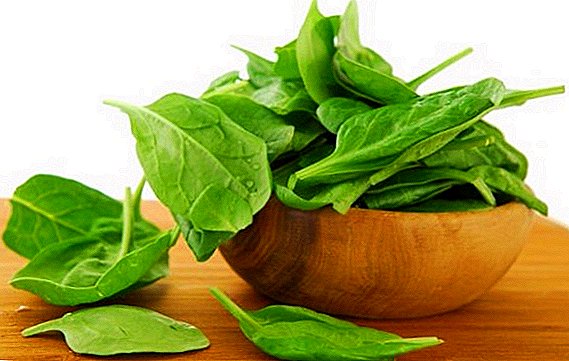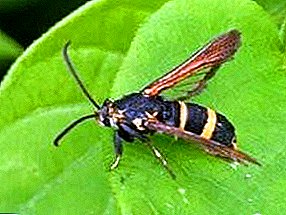
Most species of these herbivorous insects are known as pests of forest and agricultural crops.
To properly deal with malicious sawflies, you need to be able to distinguish between different types and know effective means against them.
Consider what are these parasites and how to remove them from your site in the shortest possible time.
Types of sawflies and their features
Science has discovered and studied about nine thousand species of sawflies, of which in Russia there are only two thousand. They owe their name to the external similarity of the oviposition with the saw blade. In some members of the sawfly families, the shape of the ovipositor is significantly narrower, which facilitates penetration of the tree bark.
Adults possess a double pair of thin long wings separated by veins in the form of large cells. There is a jumper between the thoracic and abdominal parts, which is slightly wider than that of other hymenoptera, like bees.
The larvae got the name caterpillarsbecause very similar to them. The larva of the sawfly can be distinguished from a completely harmless butterfly caterpillar by the number of eyes (only 2 in larvae and 6 in larvae) and legs (in larvae 6 pairs or more, while the larvae have less than 5 pairs of legs) .
The main time of the activity of sawflies is spring and summer. The most favorable breeding season is a warm autumn with minimal rainfall. Eggs are laid either on the needles or in the depth of the wood.
Birch
 Adult usually 2-2.5 cm in length, the head, the legs and the body in the region of the sternum are dark, the very belly with orangish or reddish brown, casts a glare. At the crown, the head is enlarged, the mandibles are large.
Adult usually 2-2.5 cm in length, the head, the legs and the body in the region of the sternum are dark, the very belly with orangish or reddish brown, casts a glare. At the crown, the head is enlarged, the mandibles are large.
The black antennae expand to the tips and acquire a club-shaped bright orange color. The wings are completely transparent, and at the edges there are dark markings. Adults hatch in May and June.
Larvae grow to 4.5 cm, have a light green or light green color. A thin black stripe with a yellowish edging stretches along the back. They have 11 pairs of abdominal legs and a large, light yellow head. They can often be seen from July to September at the roots and in the upper part of the branches of birch. As in the case of imago individuals, the ration of the larvae is only birch leaves.
To protect birch plantations you need:
- Carefully dig the ground near the rhizomes in the pre-winter period.
- All larvae found (sometimes in dark brown cocoons) are destroyed.
- In the summer, birch groves are sprayed with insecticides (Chlorofos and Metaphos), starting in June, to discourage adult sawflies, and at the end of July - larvae.
Spruce
 This is small (5-6 mm in length) is almost completely a black insect with a long, very thin antennae, where the yellow parts of the body are the oral apparatus, the belly and the front veins of the wings. Can be found from April to June.
This is small (5-6 mm in length) is almost completely a black insect with a long, very thin antennae, where the yellow parts of the body are the oral apparatus, the belly and the front veins of the wings. Can be found from April to June.
Light green, almost like needles, black-eyed larvae have 3 pairs of sharp dark legs at the beginning of the body and 7 pairs of false legs in the rest. Grow up to 1-1.5 cm in length. They actively feed on young needles from May to June, after which they seek shelter in the forest floor for pupation.
These insects seriously damage many species of conifers, which is why their growth is inhibited.
To prevent serious outbreaks of sawflies, needles are to be sprayed with special preparations against young larvae. It is useful to dig up the so-called pristvolny circles to detect and eliminate the nests of the larvae.
Gooseberry and yellow gooseberry
Gooseberry sawfly usually 7-8 mm in length. Very voracious in relation to the leaves of gooseberry and different varieties of currants. Outwardly, it remotely resembles a small wasp with pale paws. The larvae are light green, without any marks.
Yellow gooseberry sawfly does not grow more than 6-7 mm, the whole body, legs, sides of the head, mouth and the bases of the antennae are yellow, the other parts of the body are dark or black.
The wings are extended closer to the tips, transparent, with black or dark brown markings on the upper edges of the front pair of wings.
In larvae 20 legsthey are pale green or gray-blue, completely covered with large black spots or growths (some merge with the edges on the back).
Insects actively gnaw the leaves of berry bushes, sometimes leaving only streaks. As a result, the plants die, seriously reducing the subsequent harvest. As a preventive measure, one should dig up the ground under bushes in autumn and early spring. It will also help deter pests with a solution of tar soap, and after flowering of the bushes - coniferous extract or entobacterin.
Spraying will help protect against the larvae pyrethroids, organophosphorus compounds, neonicotinoids. For example, the solution "Chlorophos" or anabazine sulfate (before the appearance of berries).
Bread
 Grain, it is the stem sawfly not a pleasant neighbor. Narrow black insect up to 1 cm long, on a back brilliant light yellow strips and marks are located. The paws are black, with the exception of the tips of the front pair - they are yellow.
Grain, it is the stem sawfly not a pleasant neighbor. Narrow black insect up to 1 cm long, on a back brilliant light yellow strips and marks are located. The paws are black, with the exception of the tips of the front pair - they are yellow.
Imago feed on nectar and weed pollen. Larva is watery yellow, devoid of pronounced legs, 12-14 mm long. The head is light brown, and at the end of the body is a small appendix, bordered by 6-9 miniature spines.
The key insect damage is caused by bread crops: wheat, rye, barley and even oats. The larvae eat away the contents of the stems, moving toward the root, which weakens the plants and makes them brittle. When harvesting, the stems break off easily, spikelets grow weak and dry.
Imperative deep autumn plowing and double stubbling (immediately after collection) to eliminate the larvae that have sat down at the base of the stalks for hibernation. A good prevention will be early harvesting. From culture drugs can be processed "Break" or "Borey".
Ordinary pine
Possessing a large oval body, adults grow up to 1 cm in length. The body of a dark yellow or brownish shade, covered with black markings on the back and sternum. Antennae black, short, resemble a nail file. The male is completely black, thinner than a female, has feathery black antennae and yellow paws.
Large yellow larvae 2.5-2.9 cm, with 8 pairs of blades, above each of which is a dark speck. The head is dark brown or black. Wintering takes place in the soil near the pine trees or under the forest floor.
Whole groups eat pine needles to the very foundation. As a result, the trees weaken, the tops completely dry, and other pests easily penetrate into the trunks.
Of the natural pest control measures, the safest breeding anthills and feeding birds birds sawflies. Sure to to conduct timely spraying of pines with insecticides and biological preparations.
IMPORTANT: The most resistant to attack of the common sawfire is the type of the Crimean pine. When organizing new landings, it is better to give preference to her.
Rapeseed
 Insects the size of 6-8 mm, elongated, rich orange hue, with lowered black head and short black antennae.
Insects the size of 6-8 mm, elongated, rich orange hue, with lowered black head and short black antennae.
Parts of the segments on the paws with black markings, the edges of the dark transparent wings are black, on the thoracic region two large volume spots of black color are cast with highlights.
The larvae are black, faintly greenish on the sides, can reach up to 2.5 cm in length.
The main harm is cabbage cropslike canola, rutabagas, turnip, radishsometimes eat radish and turnip leaves. To prevent the development of larvae in the pupae, deep plowing of the soil is necessary during the pre-winter period, measures against weeds.
Against the mass distribution of false caterpillars will help the processing of plantings of rapeseed with the drug "Actellic"and other insecticides, as soon as the first larvae are seen on 5-10% of all plantings.
Apple
Adult order 6-7 mm in length, black or dark brown. The thoracic region is black and shiny. The paws are yellowish, the wings are dark, semi-transparent.
The larva is pale yellow, wrinkled, about 1 cm. The head is round, black, gradually brightens with age and becomes creamy-brown. 10 pairs of legs, of which three front pairs are longer and thinner than the rest.
If the apple sawfly imago is saturated only with nectar, the larvae eat the fruit of the apple, beginning with the receptacle. During its life, the larva can manage to damage from 2 to 6 fruits. In addition to actively damaging the fruit, the sawflies cause the ovary to fall.
As a prevention of the emergence of adults productively digging near-trunk circles and inter-rows. During the flowering of trees soil can be treated with hexachlorane dust. With the first development of the fruit is necessary spray apple trees with a solution of DDT and Karbofos.
Single weaver
 Insect length 13-17 mm, with a black-yellowish belly, black sternum, head and antennae. The tip of the abdomen with a large black mark. The wings are translucent, pale yellow in color.
Insect length 13-17 mm, with a black-yellowish belly, black sternum, head and antennae. The tip of the abdomen with a large black mark. The wings are translucent, pale yellow in color.
The larva is gray-green with a dark stripe along the back, the head is also light green, sometimes with a brownish tint. Can reach lengths in 2.5 cm. On the chest are 6 thin legs and one pair of prolegs at the tail.
Spider nests on pine branches, outwardly similar to elongated brown pineal formations are weaved. Pseudo-larvae devour the needles, leaving small hemp and excrement.
Photos of various kinds





Measures to combat various species of sawflies are almost similar at the stages of activity of adults and wintering of larvae. With proper and timely processing, digging up the soil and destroying nests, it is quite possible to protect the entire crop and forest plantations.
To consolidate the knowledge gained, we offer you a video about sawflies and measures to combat them:


